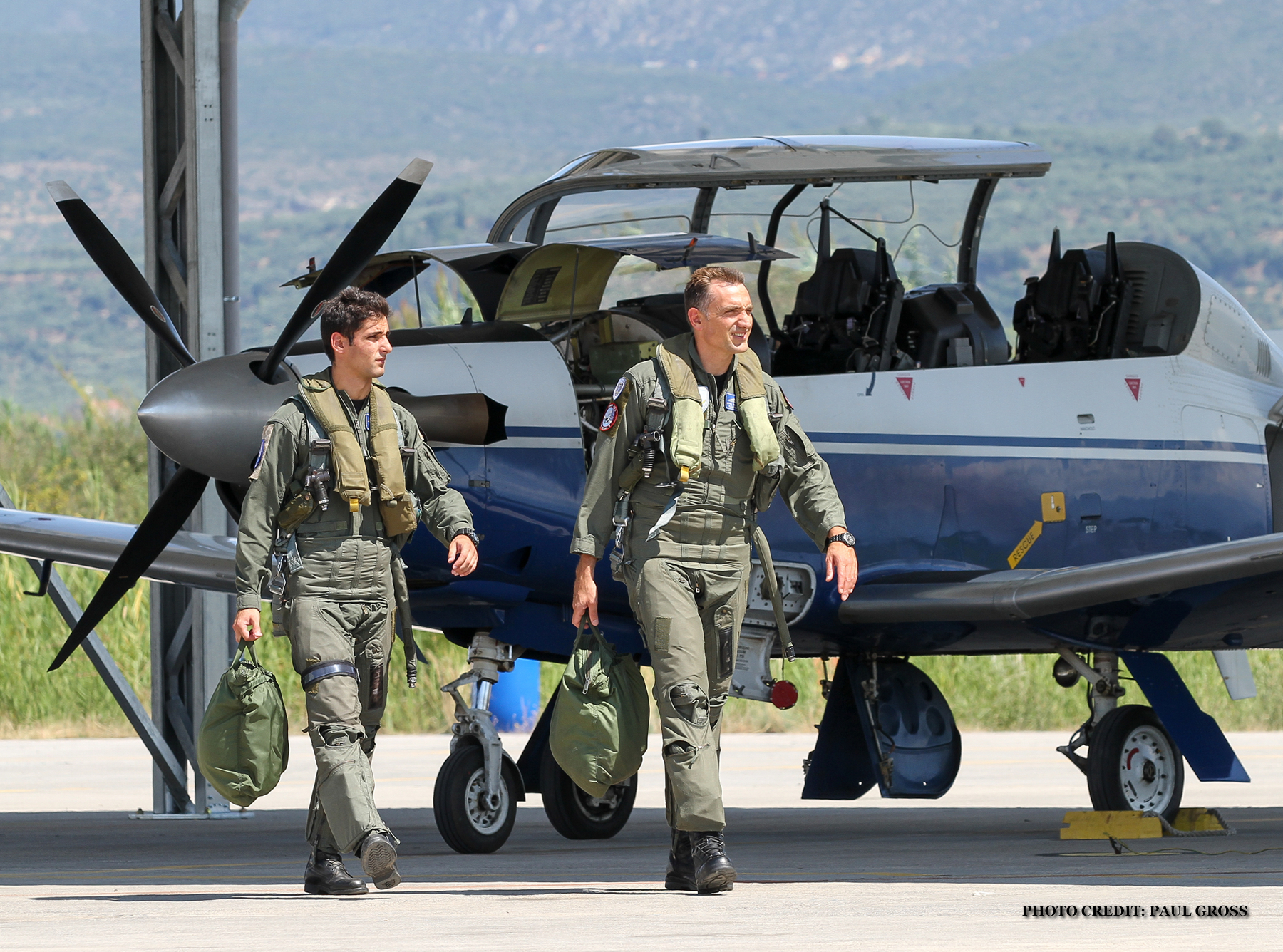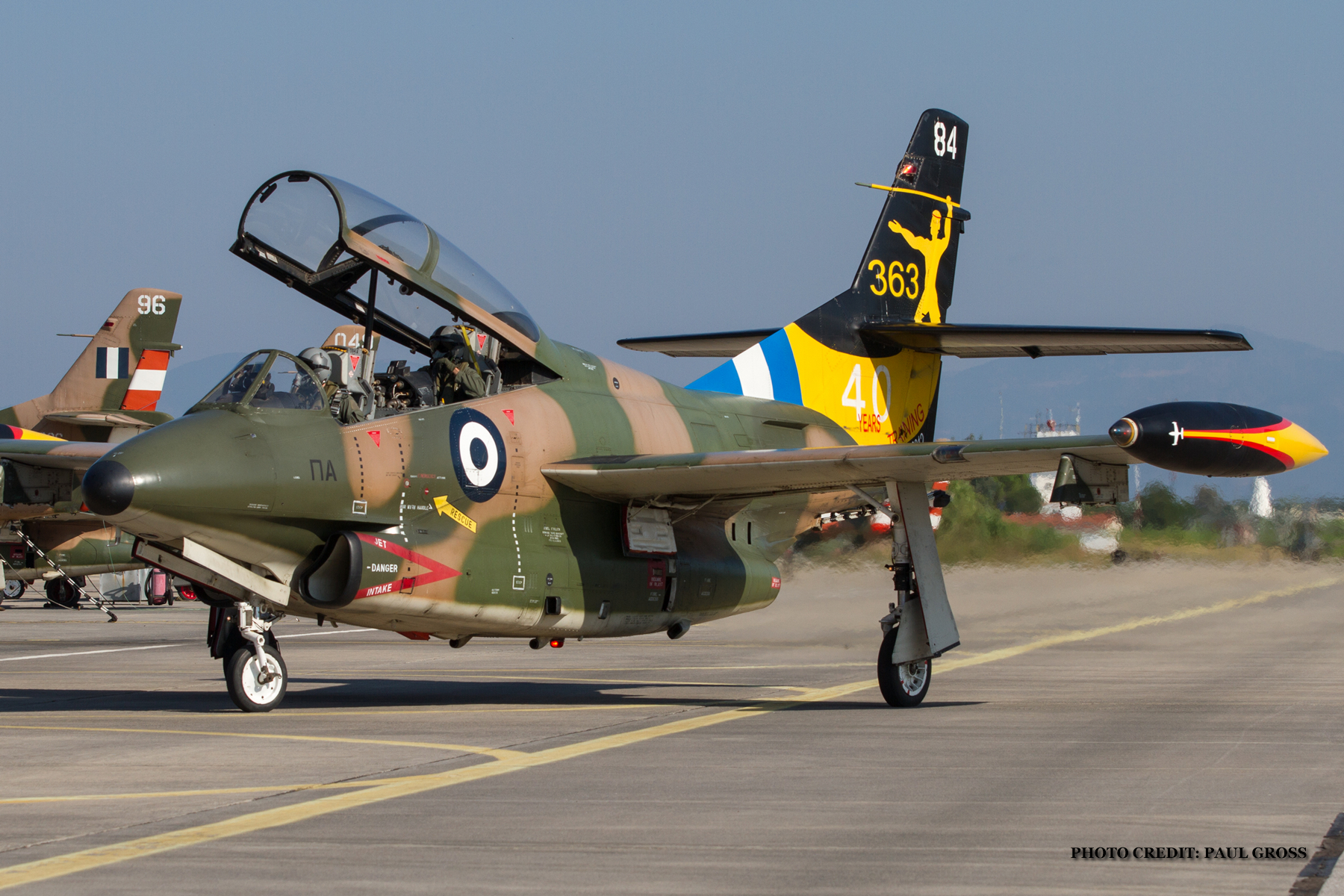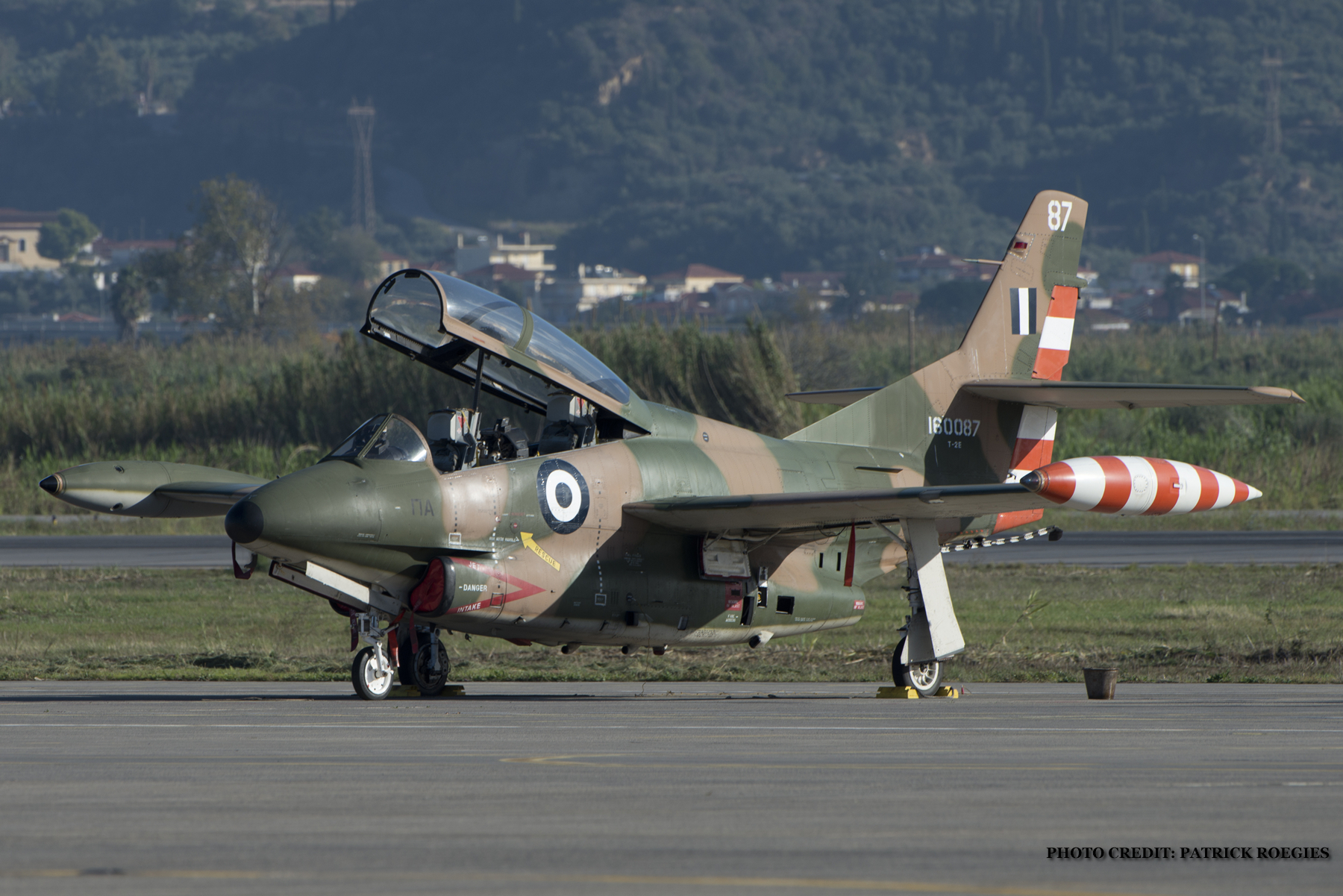
Hans Looijmans, Paul Gross and Patrick Roegies take a detailed look at the Hellenic Air Force’s (Greek Air Force) fixed-wing pilot training…
Written by: Hans Looijmans, Paul Gross and Patrick Roegies
Photos by: Hans Looijmans, Paul Gross and Patrick Roegies (as noted)
May 21, 2016
The ancient Greeks were pioneers in mankind’s dreams to fly. There are numerous myths relating to flights of gods and heroes using divine power. However, the first attempt to fly by making use of man-made equipment by Daedalus and tested by his son Ikarus are regarded as the first mythical airmen. In short: A famous architect and inventor Daedalus was invited by the King of Crete, Minos, to create a huge palace in Knossos. Both he and his son Ikarus served the King, but they were imprisoned on the island to keep the palace a secret. In order to escape, Daedalus invented wings for Ikarus made from cloth, bandages, bird feathers and wax. He warned his son not to fly to high as the sun could melt the wax. However, Ikarus ignored these words and flew to high and crashed to his death into the sea. This was the first mythical struggle of mankind to tame the skies.

In real life, military aviation in Greece started from 1912 onwards with the help of France by using the French built Farman III aircraft. The first pilots were trained in France at the Farman School in Etampes, near Paris. The Greek Farman aircraft were not only used for training, but also served for reconnaissance and even bombing missions during the Balkan War (1912-1913) which also saw confrontation with the Turks. It was only after the First World War that in 1919 a military aviation school for pilots and observers was established in Thessaloniki. For Army training the Havilland-4, Havilland-9 and Sopwith Camel aircraft were used.
At the same time the Navy Aviation formed training centers in Dekelia – Tatoi and Paleo Faliro operating the Breguet-19, Henriot H-182, AVRO 504N and different versions of Morane-Saulnier MoS trainer aircraft.
The year 1930 was a landmark to the Hellenic Air Force history as the Royal Hellenic Air Force (RHAF) (in Greek EVA = Elliniki Vassiliki Aeroporia) became a separate branch of the armed forces. The Hellenic Air Force Academy was established at Dekelia-Tatoi airfield in September of 1931 and started to operate in December of the same year, with the integrated education for the army, naval aviation and the coast guard. At that time the attendance for the duration of the training program lasted 3 years and the cadets graduated with the rank of Second Lieutenant. The training was based on the corresponding British Royal Air Force School training system. For the flight training AVRO 621 Tutor and AVRO 626 Prefect aircraft were mainly used at that time. Also Gloster “Mars” VI Nighthawk were used by the Academy till 1939 as these aircraft were no longer suitable as a frontline aircraft.

The outbreak of WW II imposed the relocation of the School to Argos, where it operated from October 1940 until April 1941. In order to escape the attack from the Italians, the School deployed in April 1941 to the Middle East and following that to South Rhodesia, where it operated as a training centre from September 1941 until summer 1946. Meanwhile the Germans occupied Greece until October 1944. Not sooner than March 1947 the School returns to Dekelia air base. The normal Air Force School’s operation starts in October 1947, when it welcomes the first students who followed a post-graduate program in England. At that time the School had minimum means to conduct ground and flight training. For flight training the school had 10-15 De Havilland 82A Tiger Moth II, 15-20 Harvard and also 15-20 Supermarine Spitfire aircraft at its disposal. Students had to carry out a total of 160 flight hours before graduation: 40 hours on the De Havilland 82A Tiger Moth II, 80 hours on the T-6A Harvard and 40 hours on the Spitfire aircraft. However the British influence faded as the Americans started to support the RHAF with equipment and training in 1949. Since then, the air training within RHAF was based on the American training system instead of the British system.
1952 starts a new period for the Hellenic Air Force School, the jet aircraft era, with the introduction of the T-33. Greece became a member of NATO in 1952. New airbases were build with the help of the US and via the US Military Assistance Program a large numbers of jets were delivered. Therefore in 1953 the cadets started training on jets and the first Jet Aircraft Flight with T-33 aircraft was established at Elefsis air base, subordinated to the School’s Training Squadron. In 1958, in the context of modernization, the School redeployed to Dekelia-Tatoi Air Base, where the Academy is based until today. From 1962 onwards, foreign students were also trained at the Academy. In 1964 the school is referred to as a higher military educational institute, equivalent to all the other national universities. The education syllabus was prolonged from 3 to 4 years from 1967 onwards and the Academy was named “Ikarus Air Force Academy”, still training pilots for all branches of the Greek military forces.

For pilot screening and basic training twenty T-41D training aircraft were delivered via the American military assistance program (MAP) in the period 1969-1970. Due to the loss of a T-41 during delivery an additional (fiscal 1970) T-41D was delivered.
In 1964, the first batch of former USAF T-37C training aircraft were delivered via the Military Assistance Program to the Hellenic Air Force at Elefsis air base. Later on, due to accidents leading to loss of aircraft, the Americans delivered another 8 T-37B aircraft and in 1988 another 8 aircraft were purchased from Jordan. In 1971 the jet training with T-33 and T-37C was relocated to Kalamata Air Base, under the command of the 120 Air Training Wing (in Greek: Pteriga Ekpedefseos Aeros).

In April 1967, the Greek Monarchy was removed and a military Junta overtook power in April 1967. The country got isolated as countries imposed sanctions on Greece as it was ruled by a military dictatorship. A US embargo was finally imposed by US congress in 1968 concerning all heavy military equipment. Greece was very much depending on NATO and US military aid. This hampered also the modernization the training aircraft. In early 1972, with Greece still under military dictatorship, the Nixon administration lifted the embargo stating to the American Congress it was necessary to strengthen the southern flank of NATO. Also Greece was an important NATO stronghold for reaching the Balkans, the Middle East and Northern Africa. These factors paved the way to somewhat modernize the Hellenic Forces. In 1974 the Greek junta engineered a coup in Cyprus. The Turks swiftly responded and invaded the island. The junta collapsed and Greece became a Republic, reinstating the democracy again. The name of the Air Force was changed to the Hellenic Air Force (in Greek: Elliniki Polemiki Aeroporia or EPA). All the remaining embargoes were lifted and a large number of modern aircraft could be delivered via various programs. This included 40 T-2E Buckeye jet trainers that were delivered from 1976 onwards directly to Kalamata Air Base. This tandem aircraft was an export version of the T-2C which was used by the US Navy to train their pilots even for carrier qualifications. With the introduction of the Buckeyes within the HAF, the old T-33 trainers could retire. The Buckeye has no internal weapons, but external stores allow it to carry and deliver weapons (rockets, gun pods and bombs). As a high performance jet the T-2E took over the advanced jet training, leaving the basic jet training to the T-37C aircraft until the T-37C was withdrawn from use in 2002. The HAF bought five T-2C aircraft for active service from the US Navy in 2000 to keep enough T-2 aircraft available for flight operations. These aircraft had become obsolete by the US Navy. In 2008 another seven T-2C aircraft were delivered from US storage (309th AMARG, Davis Monthan AFB) to Kalamata Air Base. These aircraft are used for spare parts. They still wear their white-red US Navy color scheme and their AMARG storage number. After 25 September 2015 the HAF is the only operator of the T-2 Buckeye worldwide, as the last US T-2C’s used by the test facility at Patuxent River were withdrawn from use. As stated the T-2 Buckeye is in origin a naval trainer. Highly visible is the red-white arrestor hook for carrier (or barrier) landings. Les visible is the fact that the nose wheel of the Buckeye is fixed so the wheel cannot turn by itself. Steering of the aircraft through corners needs to be executed by using the brakes on the other wheels also known as differential braking.

360 Air Training Squadron had been using five Grob G103A aircraft from 1984 till 1999. These gliders had been bought by the Air Force between 1984 and late 1986 in order to provide additional flight training to air cadets of all specialties but mostly to pilots. Its usage was initially scheduled for 2nd and 4th year air cadets, but early enough this had been changed to voluntary use. Their retirement was caused by a combination of Squadron’s demanding flight program, which didn’t allow efficient usage of these gliders. Following their retirement, the Grob G103A aircraft were donated by the Air Force to Air clubs in order to promote the spirit of aviation.

Like the Americans, the HAF decided to replace the old T-37C aircraft by the turboprop Raytheon T-6 Texan II aircraft that was designed for preparing pilots to fly state of the art fighter jets. The first of these T-6 aircraft were delivered to the HAF in 2000. Of the 45 aircraft that were delivered 25 are standard T-6A Texan II aircraft, the remaining 20 are T-6NTA Texan II aircraft. The T-6NTA differs from its T-6A brother as the T-6NTA has hard points mounted under the wings, giving it the ability as a weapons training aircraft and a light attack aircraft (when needed) with the ability to carry external fuel to give it extra range.
Current Flight Training:
The Hellenic Air Training Command (HATC), that origins from 1955, is situated at Dekelia-Tatoi air base. The HATC mission is to plan, program, monitor, assess and improve the training provided to the Hellenic Air Force personnel. Not only for pilot training, but also for military technical and tactical training at the Academy for officers and NCO’s. This article will focus on the fixed wing air training.
During a three month period the young pilots are screened on their basic flying skills in order to evaluate if the young pilot have the skills to become a pilot in the Hellenic Forces. Besides theoretical and military education, they make 19 flight hours on the venerable T-41D. No fewer than 18 of these Cessna 172 trainers are still in use with 360 Air Training Squadron (Moira Aeroporikon Efarmogon, MAE) to this day. This Air Training Squadron is part of the Hellenic Air Force Academy. Annually between 50 and 100 young pilots are screened by the Academy.

About 85% to 95% of the screened pilots complete this first selective phase successfully. Then the young pilots move on to the 120 Air Training Wing at Kalamata Air Base. Though Kalamata Air Base also has a civil apron, the base also has a detachment of 351 MAE PZL M-18 Dromaders are stationed there during the summer for firefighting operations. Standard a UH-1H helicopter is available for SAR operations. However, most flight operations are executed for pilot training. For this training 120 ATW controls the based 361 ATS (T-6A Texan II), 362 ATS (T-2E/2C Buckeye); 363 ATS (T-2E/2C Buckeye) and 364 ATS (T-6NTA Texan II).
When selected for the first “Initial” phase of training, the young pilot joins 361 Air Training Squadron (361 MEA) to learn in about 60 flight hours and a lot of theoretical hours and flight simulation the basic flight procedures (including safety), handling the basic T-6A Texan II aircraft and to develop as a pilot (planning, decision making, taking responsibility). The second “Basic” phase is executed with 364 Air Training Squadron (364 MEA) on the T-6NTA Texan II. This phase is all about instrument flying, navigation skills, formation flying and a first introduction to an aircraft that is capable to carry and deliver weapons. To achieve these skills the student has to manage the theoretical and practical part of this syllabus. Besides ‘flying’ the flight simulator, some 78 successful flight hours need to be logged to graduate this phase. In order to enhance pilot training, both Italy and Greece agreed to exchange pilots in order to share training facilities. After completing “Initial” training on the SF-260 at Latina Air Base, selected Italian pilots are transferred to 364 ATS to exploit the better training possibilities on the modern Texan II. For this purpose a few Italian Air Force instructor pilots are assigned to 364 ATS.

For the “Advanced” training phase the pilot is introduced to 362 ATS flying the T-2E/T-2C Buckeye. Besides the theoretical part and 20 hours in the T-2 flight simulator, the pilot will need to accumulate 72 successful flight hours on the Buckeye. Mastering to fly this jet in different circumstances, including dealing with emergencies, instrument flying and formation flying is the goal of this part of the training. The pilot is challenged to react faster, to adapt to challenging circumstances, to take responsibility in formation flight, etcetera. Fast jet experience will help the pilot to become a better pilot. After this phase the pilots are selected for combat jet training. The pilots who are not selected to fly combat jets will move on to be trained on transport aircraft or helicopters, while the to be combat jet pilots need to master the final “Operational” phase under the wings of 363 ATS also flying the T-2E/T-2C aircraft. This is about studying combat maneuvers and weapon training. The usual mixture of ground training and practical training will be finalized after 60 successfully completed flight hours. Selected Greek pilots are able to join the 212 Gruppo/61 Stormo at Lecce Air Base in Italy, to become an exchange pilot flying the more modern MB-339CD instead of conducting the “Operational” at Kalamata air Base. Flying the MB-339CD jet trainer or even the latest state of the art T-346A jet trainer is much more modern compared to the T-2E/T-2C as it has a head up display and other features that tightens the gap to fly the state of the art combat jets. After graduating the final phase the new combat jet ready pilots will be assigned to a tactical conversion unit on the aircraft type they are assigned to. This can be F-4, F-16 or Mirage 2000. The conversion unit will train the new pilot to master the jet in combat conditions. When ready the pilot is transferred to an operational unit of the type of jet and well prepared to defend the homeland.
The future of HAF pilot training: A constant requirement of HAF is to improve every aspect of training. In this framework, all possible ideas are explored in order to achieve the best outcome. In other words, HAF is exploring both the possibility of purchasing a new training aircraft along with the participation in another country’s training program. The economic crisis has had no impact on the training schedule of the cadets so far. There seems to be no plans to replace the T-41 and T-2 aircraft on short term. Moreover, combining the training facilities with other NATO countries can provide the opportunities to prepare new pilots for a smooth transition to operate modern combat aircraft. The successful exchange program with the Italians is certainly one of them!
The authors would like to thank everyone in the Hellenic Air Force who contributed in making this article possible!
Click on an image below to page through the gallery:
Patrick Roegies is born and raised in Tilburg, the Netherlands and currently resides in Sittard in the south of the Netherlands where he lives with his wife Joyce. Patrick graduated from a technical study at the HTS in Tilburg in 1997. He currently works as a head of an equipment engineering department in the south of the Netherlands.
His passion towards aviation started at the age of 7 in 1977 when his father took him to nearby Gilze Rijen Air Force base where he witnessed his first howling F-104 Starfighters which were practicing and as a result he got addicted immediately. The F-104’s were present in order to determine a tactic to create a diversion for the “train highjack” which was going on in the Netherlands at that time. The F-104’s were meant to create a diversion by performing an overshoot, kicking in the afterburner directly over the train, creating confusion with the hijackers and enabling the police to master the hijackers. This action has actually been performed and worked.
This is when his passion towards aviation was born. He got permission from his parents to visit the airbase every free hour he had and his father showed him the way by bicycle. Patrick got his first camera in 1984 which was a Canon T50 and shot Kodachrome 64 slides of mainly military aircraft. He changed his gear in the mid-nineties to Nikon and is a Nikon user ever since.
When Patrick obtained his driver license in 1989 he started to visit airbases all over Europe and from 1997 onwards he made worldwide visits to military airbases.
In order to further professionalize his work as an aviation photographer and journalist he started to write military aviation related articles based upon his visits to various nations and their Air Forces. He managed to publish his first article in 2003 and increased the numbers of publications every year.
Patrick can be reached at: [email protected]


